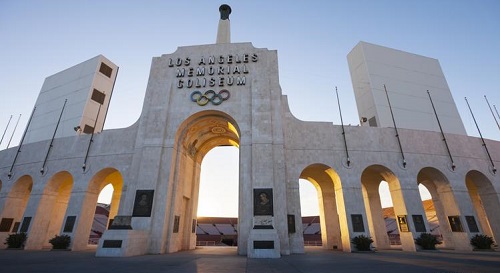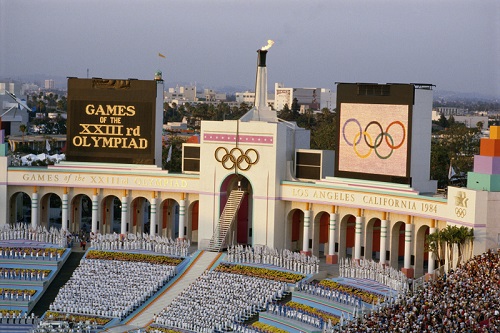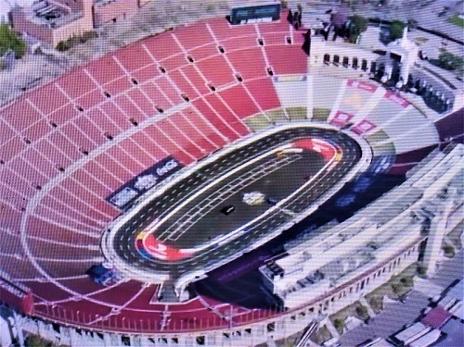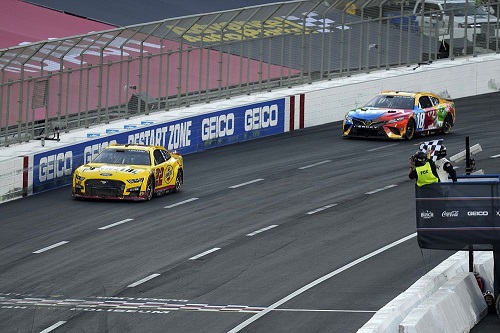LOS ANGELES MEMORIAL COLISEUM - LOS ANGELES CA

The Los Angeles Memorial Coliseum (also known as the L.A. Coliseum) is a multi-purpose stadium in the Exposition Park neighborhood of Los Angeles, California. The Coliseum was commissioned in 1921 as a memorial to L.A. veterans of World War I (rededicated to all United States veterans of the war in 1968). The groundbreaking ceremony took place on December 21, 1921, with construction being completed in just over 16 months, on May 1, 1923. When the Coliseum opened in 1923, it was the largest stadium in Los Angeles, with a capacity of 75,144. On October 6, 1923, Pomona College and USC played in the inaugural game at the Coliseum, with the Trojans
prevailing 23–7. Situated just across the street from Exposition Park, USC agreed to play all its home games at the Coliseum. In 1930, however, with the Olympics due in two years, the seating capacity was expanded to 101,574. In 1932, the Coliseum hosted the Summer Olympic Games, the first of two Olympic Games hosted at the stadium. It was used for opening and closing ceremonies as well as several events. The Olympic Cauldron used in 1932 was also used when the Olympics returned in 1984. The cauldron is a main sight on stadium and is still present in the Stadium and is lit during special events. Just a few include: Space Shuttle Challenger disaster (1986); September 11 attacks (2001); official period of mourning after the death of the former American president Ronald Reagan. (2004); the death of


Pope John Paul II (2005); and the confirmation as the host city of the 2028 Summer Olympics. (2017). The former Cleveland Rams of the National Football League relocated to the Coliseum in 1946, becoming the Los Angeles Rams. The team moved to other cities; but returned to LA in 2016 and played at the Coliseum while awaiting completion of construction of SoFi Stadium in Inglewood CA. The Coliseum was also the site of John F. Kennedy's memorable acceptance speech at the 1960 Democratic National Convention. In 1973, Evel Knievel used the entire distance of the stadium to jump 50 stacked cars. Knievel launched his motorcycle from atop one end of the Coliseum, jumping the cars in the center of the field, and stopping high atop the other end. The jump was broadcast on ABC's Wide World of Sports. The Oakland Raiders moved to the Coliseum in 1982 and played there as the L A Raiders until 1994. Some other notable events
held at the Coliseum include: Major League Baseball;
Soccer; Motocross races; and many concerts. And finally (for our purposes) we have NASCAR come to the facility. To open the 2022 season, the Busch Clash was moved here from Daytona; where it had always been ran. It was quite a project to make a race track over top of the football field without damaging it. First, a thick plastic barrier of Visqueen sheeting was put down on the grass, turf and red dirt – basically the entire floor level of the stadium. Plywood was placed atop. A sheet of geotextile woven fabric lies as a divider between the protective measure and track rumble. It prevents any slipping and sliding, too. Crushed miscellaneous base – 9,200 cubic yards worth – gives the surface a majority of the depth. There’s a foot of the fill below the flat infield and four feet on the outside

with 2.5-degree banking. Asphalt then covers everything — 6,900 square yards to pave the track and apron; 6,800 for the infield — adding another four inches deep. As for the race: 36 teams made the first trip out west to run in the race. Practice was held on Saturday February 5th and qualifying that evening. On Sunday February 6th; four 35 lap heat races were led. The top four finishers of each race advanced to the feature. Then two 50 lap 'last chance' races were held; with the top three advancing. The final spot went to the driver who finished highest in the 2021 Cup series points, who had not advanced through the races. There were 23 starters for the Busch Clash. Kyle Busch was fast qualifier and also won his heat race; putting him on the pole for the Clash. This was a short "sampling" to see if the new cars would level the playing field; but we did see several drivers run up front that normally haven't. Ryan Preece; Justion Haley and Chase Briscoe were strong all weekend. Busch and Tyler Reddick ran side by side the first three laps before Reddick broke out on top. He led 50 laps and his transmission failed while under yellow flag conditions. Busch assumed the lead with Joey Logano close behind. Busch led 62 laps before he ran wide; and Logano jumped under him and muscled his way into the lead. Joey would lead all the way to the checkers to get the win. Busch was second, Austin Dillon, Erik Jones, and Kyle Larson made up the top five. Rumors are NASCAR will have this as the location for the Busch Clash the next several years.
All Photos copyright and are property of their respective owners
